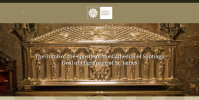If you're looking for a pilgrimage where you can be alone with your thoughts a lot of or most of the time, look into the Shikoku 88 temples Buddhist pilgrimage in Japan.
There are several route options for the Way of Saint James that are quite lonely until you reach the final stretch into Santiago.
Similar as to the Ways to Rome.
It's an interesting article, though as to :
It’s a long walk across a whole country, but compared to the long trails in the States, it’s pretty soft. There are towns, hostels, and bars at two-hour intervals the entire way. It can be genuinely busy, with something near half a million people walking every year. There’s no actual wilderness involved.
It's of course not "
a long walk" but a huge network of pilgrimage Ways, some of which are longer than any of the Triple Crown thru-hikes, and some of which do pass through wilderness and semi-wilderness.
Sometimes you will be completely alone on your walk, though even on a very long and solitary Camino, the dense rural and semi-rural infrastructures of Western Europe do mean that you will be seeing local people and passing through villages virtually every day.
But
this is Europe versus the USA, not Camino versus thru-hikes -- even on the Via Alpina, which is longer and
topographically more challenging than any of the Triple Crown thru-hikes (which will certainly be more challenging in other ways), you will be passing through villages and towns with some frequency, and the mountain lodges along the VA will more frequently offer food and a degree of comfort, instead of it being nearly always camping out in the wilderness, though that's necessary too. At least as I understand things from reading about the VA.
It's really the difference between long-distance hiking in a Continent developed from thousands of years of civilisational development and one with about 500 years of it. Most of the Central and Western European Wildernesses have been either tamed or constrained, whereas only a portion of the American ones have been.
The challenges are both different and similar -- but to draw comparisons between the
Francès in solitary and the PCT, CDT, and AT as a conglomerate will necessarily be misleading.

 thetrek.co
thetrek.co




















